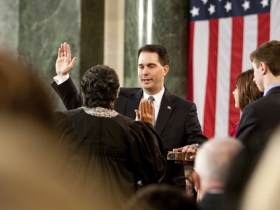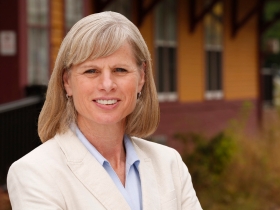Walker Has Huge Cash Advantage
He's raised $24.5 million compared to Burke's $15.5 million, with twice as much of his donations coming from out of state.
No one can deny that spending by often-shadowy outside groups plays a huge role in elections. But much of the cash lavished on elections still flows directly to and from the candidates’ campaigns, which must make detailed public disclosures.
Mike McCabe of the nonpartisan Wisconsin Democracy Campaign predicts that in the state’s current race for governor, the candidates will account for about two-thirds of the $55 million to $60 million he expects to be spent overall. That’s the same ratio as for the 2010 governor’s race, in which an estimated $37 million was spent. (Outside groups played a larger role in the 2012 recall.)
Pre-election campaign finance reports filed Oct. 27 show that Republican Gov. Scott Walker has raised $19.9 million so far this year compared to Democratic challenger Mary Burke’s $13.5 million, including $5 million of her own money. Walker spent $21.6 million in 2014 and had $3 million cash on hand. Burke spent $11.9 million and also had about $3 million on hand.
These numbers only tell part of the story.
The Wisconsin Center for Investigative Journalism, using data reported to the Wisconsin Government Accountability Board, looked at receipts and spending by both candidates from Oct. 4, 2013, the date of Burke’s first contributions, through Oct. 26, 2014, including some late contributions past the filing cutoff for the last report.
Some findings:
- During this roughly 13-month period in which he had a declared opponent, Walker raised a total of $24.5 million, compared to Burke’s $15.5 million.
- Walker received about $10.8 million from other states, or 44 percent of his total. Burke attracted $3.2 million in out-of-state donations, or 21 percent of her total.
- Walker’s campaign had 232 individual donations of $10,000, the maximum, compared to Burke’s 69. Walker also had many more donations of $1,000 or more, 4,526 to Burke’s 1,439.
- In all, Burke received about 130,000 individual donations, averaging $74. Walker had about 150,000 individual donations, averaging $140.
Despite his sizable fundraising edge, Walker has complained that his side is being outspent, in terms of TV ads. He’s correct: As of Oct. 20, according to the Center for Public Integrity’s State Ad Wars Tracker, Burke and her supporters had aired about $8.2 million in commercials, compared to $7.4 million from Walker and his supporters.
But this is just one measure of the campaigns’ respective firepower. Other measures show that Walker’s campaign is vastly outgunning Burke’s.
Since Burke entered the race last fall through Oct. 20, the cutoff date for reporting expenditures to the state, Walker has spent a total of $23 million to Burke’s $12.6 million.
Filings with the Federal Communications Commission tracked by the Sunlight Foundation show that both Walker and Burke have made multiple additional ad buys since the expenditure reporting cutoff. TV viewers, brace yourself.
The reports show that Walker has topped Burke in other key categories, including direct mail appeals to potential donors and supporters. His campaign has invested more than $4 million in this cause, compared to Burke’s $819,000.
Wisconsin’s other major statewide contest, for attorney general, is a relatively modest affair. Since entering the race last fall, Republican Brad Schimel has raised about $1.2 million, including reported late contributions. Democrat Susan Happ, who entered the race in February, has raised just over $900,000.
Once upon a time in Wisconsin politics, sums like this were considered a lot of money.
Bill Lueders is the Money and Politics Project director at the Wisconsin Center for Investigative Journalism (www.WisconsinWatch.org). The Center produces the project in partnership with MapLight.
The Center collaborates with Wisconsin Public Radio, Wisconsin Public Television, other news media and the UW-Madison School of Journalism and Mass Communication. All works created, published, posted or disseminated by the Center do not necessarily reflect the views or opinions of UW-Madison or any of its affiliates.
-
Legislators Agree on Postpartum Medicaid Expansion
 Jan 22nd, 2025 by Hallie Claflin
Jan 22nd, 2025 by Hallie Claflin
-
Inferior Care Feared As Counties Privatize Nursing Homes
 Dec 15th, 2024 by Addie Costello
Dec 15th, 2024 by Addie Costello
-
Wisconsin Lacks Clear System for Tracking Police Caught Lying
 May 9th, 2024 by Jacob Resneck
May 9th, 2024 by Jacob Resneck




















Okay a ~$9M header in direct donations (which in and of itself speaks volumes about the depth and strength of “belief” in the candidate that contributors are ponying up for!). But that advantage is dwarfed by what Organized Labor boasted that they would spend in WI to defeat Scott Walker earlier this year (source http://watchdog.org/129731/elections-unions-republicans/) :
Big Labor pledges it will go all in, again, in its drive to knock out its top political adversaries in 2014.
And one of the biggest targets is Wisconsin Republican Gov. Scott Walker, hero to conservatives, bane of the left for his public-sector collective bargaining reforms.
MAD MONEY: AFL-CIO President Richard Trumka wants to make the minimum wage the No. 1 issue this election year. His Big Labor pals are willing to spend heavily to go after five Republican governors, including Wisconsin’s Scott Walker, who have cost unions some of their power base over the past few years.
Michael Podhorzer, political director of the AFL-CIO, in a New York Times piece last week said the nation’s labor unions look to spend at least $300 million going after Republicans in this fall’s elections.
Much of that spending is expected to be dropped on four industrial battlegrounds — Michigan, Ohio, Pennsylvania and Wisconsin, traditional union strongholds. Big Labor also wants Florida.